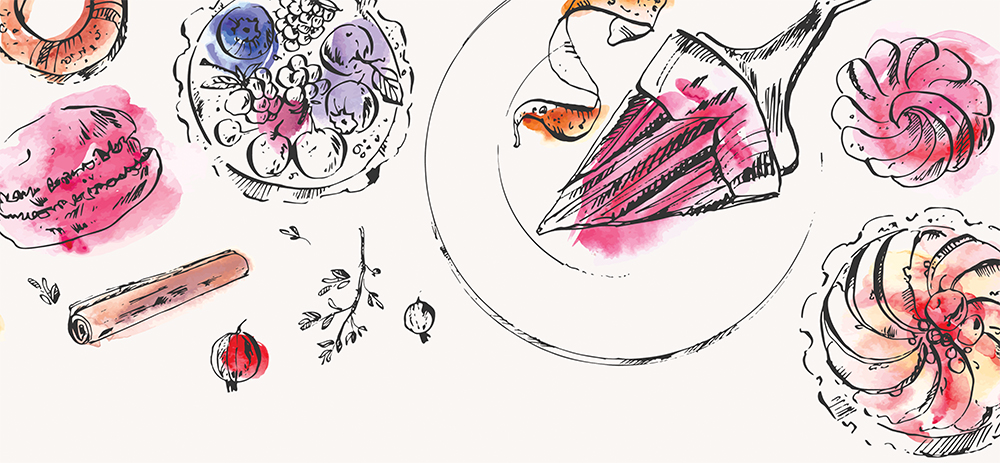Dr Sue Bailey takes a second slice of food history with the help of more Cambridge-based food writers, exploring puddings and potions
There is a hot debate as to whether it was the famous Cambridge or Trinity burnt cream that came first, or the French dessert pretender, the crème brûlée. But what has the salamander lizard we mentioned last issue got to do with it, and why would you use one?
There is a myth that salamander lizards can survive fire, which explains why, since the 1700s, a cast-iron, flame-heated disk called a salamander has been used to brown the tops of such dishes. Now however, a more advanced technology has taken over.
So, although both a crème brûlée and the Cambridge burnt cream have caramelised sugar tops, the jury is out as to whether they are the same and which came first. I spoke to Tristan Welsh – now head chef at Parker’s Tavern, who’s a long-term lover of this rich custard dish, and a passionate student of its history
Tristan recounts: “College cooks were making a variant of this unctuous cooked cream dessert topped with scorched sugar long before French chefs ‘invented’ crème brûleé. But I love a bit of controversy, and I don’t mind a bit of disagreement with the French. I’ve been a passionate collector of antique recipe books since my youth and I’ve found references to this Cambridge recipe from 1740.”
He agrees that to look forward, you always have to look back. “This is how a lot of these recipes came about in the first place – adapting to modern times. We now do a thin separate layer to create a windowpane of caramel on top for the perfect ratio of bitterness contrasted with the luxurious cream.” When asked about a cookery book, he says: “Watch this space…”
Keen to further explore the truth of this Cambridge connection, I also spoke to food historian, author and broadcaster Dr Annie Gray. She gets a bit irritated about the almost fetishisation of recipe origins. She prefers the story recounted in Florence White’s 1932 book Good Things in England. Florence calls the dessert ‘caramel cream from Trinity College’ and suggests the recipe was originally offered to the college kitchens by an undergraduate and contemptuously rejected. But when he became a fellow in 1879, the recipe was offered again and suddenly found great favour. “Recipes go in and out of fashion”, comments Annie. “But I do have a recipe for burnt cream from 1691 that had quite a lot of candied lime peel.”
You can’t walk around Cambridge without having a feast for the eyes
Trinity College tries not to get drawn in, cleverly updating this dish for the college’s 700th anniversary last year, with the pastry chef brigade developing a chelsea bun-style dessert with semi-dried and marinated cherries, crab apple and lime curd topped with lime zest and crystallised rose petals, injected with Trinity burnt cream. As a result of a global naming challenge won by Trinity alumnus Simon Willis, it gained the rotund name of Trinity Trindle. I also learnt the verb, ‘to trindle’ means to roll, to progress.
When I spoke with Annie, she told me that since authoring her first book, The Greedy Queen, a culinary biography of Queen Victoria, she has been deep in the process of editing her biography of Georgina Landemare, called Victory in the Kitchen: The Story of Churchill’s Cook – which is due out next spring. As Annie says: “Georgina – that’s my next real book. It’s very close to my heart. It is also a book that really needed writing.” In addition, Annie mentions her Downton Abbey recipe book, written two years ago, will be released to coincide with the film in September. “Much more locally, I have also been advising at Audley End with English Heritage involving Kathy Hipperson as the character re-enacting the house cook Mrs Crocombe’s recipes.”
Moving on from fashionable Victorian desserts: Cambridge food researcher Lesley Steinitz is more interested in Edwardian potions for virility than puddings. She is fascinated with Dr Tibbles’ Vi-Cocoa. This stimulating cola-based Edwardian hot chocolate drink was designed to make men vital and strong, and was a triumph of early clever marketing as a health food. She explains: “It’s like British Coca-Cola – it was very high in caffeine. It was advertised as helping the workers to get through the day – helping you to be a new man.”
Lesley is surrounded by delightful 19th-century advertising for her favourite cocoa, which “pulled in politics, nationalism and pride, how to be a real man as well as nutrition and gentlemanliness”. She is currently researching industrial health foods and culture during Britain’s decadent era, and writing up her PhD.
Perhaps Lesley describes best why it is so brilliant being a researcher and writer in Cambridge. “It’s like a breath of fresh air. There are so many different people, influences and viewpoints. You can’t walk around Cambridge without having a feast for the eyes. Lovely independents and cafes – having lived in London all my life, it was a total revelation that you could have all these things in a city the size of a sixpence that you can walk across.”
So, perhaps that’s why we have so many happy writers and foodies.

